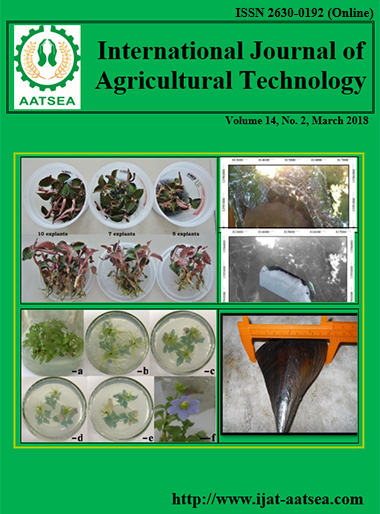Fruit Size and Soluble Solids Content in Relation to Growth and Development of Longan (Dimocarpus longan)
Main Article Content
Abstract
The purpose of this research was to apply measurement of soluble solids content (SSC) which is an important noticeable change to describe the growth during ripening of longan fruits (Biaokhiao cultivar) in order to contribute to the phenology studies and the information can help assist the development of longan management and control protocols. It was found that the SSC increased rapidly in parallel with enhancing fruit size and maturity until around week 27 after floral emergence. At the end of the ripening process, it reached the maximum level at 25.07±1.21 ºBrix when the longan fruits were around 95% of the final size. After that, SSC started to significantly and quickly decrease even though the fruit size was still slightly growing.
Article Details

This work is licensed under a Creative Commons Attribution-NonCommercial-NoDerivatives 4.0 International License.
References
Beckles, D. M. (2012). Factors affecting the postharvest soluble solids and sugar content of tomato (Solanum lycopersicum L.) fruit. Postharvest Biology and Technology 63:129-140.
Davenport, T. L. and Stern, R. A. (2005). Flowering. In: Menzel, C. M. and Waite, G. K. (Eds.), Litchi and Longan: Botany, Production and Uses. Wallingford, UK: CABI International
Itai, A. and Tanahashi, T. (2008). Inhibition of sucrose loss during cold storage in Japanese pear (Pyrus pyrifolia Nakai.) by 1-MCP. Postharvest Biology and Technology 48:355-363.
Jiang, Y., Joyce, D. and Lin, H. (2011). Postharvest biology and technology of tropical and subtropical fruits. Woodhead Publishing Limited.
Phama, V. T., Herrerob, M. and Hormazac, J. I. (2015). Phenological growth stages of longan (Dimocarpus longan) according to the BBCH scale. Scientia Horticulturae 189: 201-207.
Plant Varieties Protection Office. Department of Agriculture. (2002). Plant Germplasm Database LONGAN. The Agricultural Cooperative Federation of Thailand Ltd., Jatujak, Bangkok, Thailand.
Shuai, L. Li, J., Niu, J. J., Qian, P. H., Liu, W. H., Xue, X. Q., Han, D. M. and Wu, Z. X. (2016). Sucrose-metabolizing enzymes and their genes in the arils of two Dimocarpus longan cultivars. Biologia plantarum 60:741-748.
Xu, J. H., Xu, L., Yu, D., Wei, X. Q., Jiang, J. M., Zheng, S. Q. and Wu, S. H. (2009). Respiration rate, cell membrane permeability and some quality traits of the fruit of late longan cultivars in the tree. Chinese Journal of Tropical Crops 30:1083-1087.
Xu, X. D. Zheng, S. Q., Huang, J. S., Xu, J. H., Lin, Y. L. and Liu, H. Y. (1997). Studies on fruit development of extremely late maturing species of longan. II. Dynamic changes of fresh and dry weight, the requirement and distribution of moisture and solute content in fruits. Journal of Fujian Academy of Agricultural Sciences 12:19-23.


